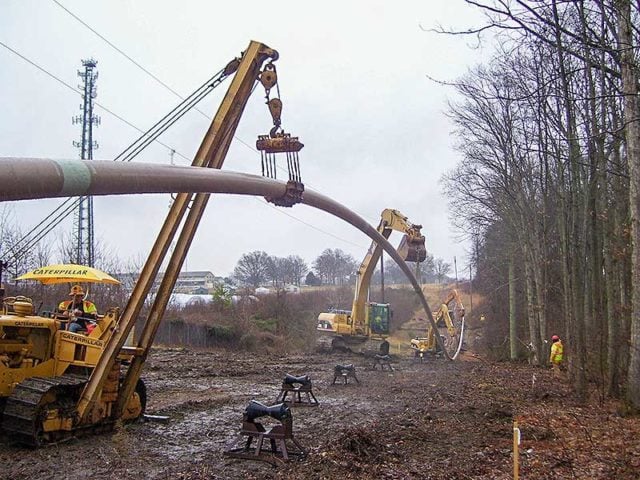Show Notes
For the seventh consecutive year, RK&K has been ranked in the Top 20 in Trenchless Technology Magazine’s 2021 Top 50 Trenchless Engineering Design Firms.
While most trenchless technologies were originally aimed at addressing deteriorated sanitary sewer piping, these technologies now encompass other utility markets. Advancement in the trenchless industry continues to grow and utility owners are given more opportunities than ever to address aging infrastructure in place without the need for disruptive and costly excavation.

Keith Eysaman | Sr Manager, Municipal Engineering | Baltimore, MD
Keith Eysaman, Senior Manager in RK&K’s Environmental department, has more than 28 years of experience in wastewater infrastructure design, focusing on utility infrastructure inspection, assessment, and rehabilitation design. We recently spoke with Keith, and he answered our burning questions about trenchless technology and explained its advancements in addressing infrastructure deterioration.
How did RK&K become involved in trenchless technology?
RK&K’s history in the trenchless technology field spans several decades. More than 25 years ago we began assisting the City of Baltimore with the inspection and condition assessment of their sanitary sewer system as part of their federal consent decree compliance requirements. As part of that work, we completed remote televised inspection of the sanitary sewers, followed by the characterization of conditions.
Due to the requirements of the repairs and potential community disturbance associated with excavating these utilities, we studied several rehabilitation technologies and their effectiveness in addressing structural defects and reducing inflow and infiltration into the sanitary sewer system.
Work associated with these projects used trenchless technologies and led to preparing rehabilitation documents for more than 1 million linear feet of deteriorated pipelines in the mid-Atlantic region.

How has trenchless technology progressed from traditional water/sewer work to other infrastructure elements?
For a decade or so we have used trenchless products such as cured-in-place pipe (CIPP), PVC panel liners and spray applied cementitious, geopolymer, and epoxy coatings to rehabilitate stormwater piping as well as large culvert piping. We have completed numerous structure and culvert rehabilitation projects for municipal transportation authorities, universities, public work agencies, and other municipal authorities.
Our team has rehabilitated piping systems ranging from a 15-inch-diameter conveyance system to repairs more than 110 inches in diameter. This has been done using technologies such as CIPP lining to the geopolymer rehabilitation of several thousand feet of deteriorated 78-inc-diameter corrugated metal piping (CMP) under a university’s athletic field.
What compels you to use trenchless technologies?
The capabilities of the trenchless technology field is everchanging and offers utility owners an alternative to traditional excavation and replacement repairs. There always seems to be new technologies emerging or an existing technology reinvented through advancements in materials and application methods. For example, less than a decade ago, we would not have considered completing an in-situ structural repair of a fragile 10-foot-diameter brick and stone storm drain; it would have been a dig-and-replace-type repair that would have created significant disturbance and the repair would have taken months to complete.
However, just a few years ago, we completed an emergency in-situ repair of a severely deteriorated 10-foot-diameter stormwater structure under a busy intersection using a CIPP liner system in about a month. This repair remains one of the largest CIPP liners installed to date in the U.S. and was presented during a trenchless conference in 2016.
We have also been involved in preparing design documents for the in-situ rehabilitation of more than 2,550 LF of 78-inch-diameter reinforced concrete piping (RCP) gravity sewer using CIPP lining, as well as rehabilitating more than 2,100 LF of 78-inch-diameter Prestressed Concrete Cylinder Pipe (PCCP) pressure sewer using a carbon fiber-reinforced polymer lining system.
This project remains one of the largest/longest applications of a pressure-rated carbon fiber repair competed in the U.S. and received an Honorable Mention Award from ASCE for Trenchless Project of the Year in 2015.

Where do you see trenchless technology going in the future?
The application of trenchless and semi-trenchless technologies to repair existing utilities seem almost endless. The key is aligning the correct technology to the needed repair to produce the highest likelihood of success. Trenchless repairs are not a “one-size fits all solution,” rather it provides the utility owner with another tool that can be used to complete repairs while limiting disturbance in the correct applications.
The rehabilitation technologies that started in the water/sewer industry to stormwater applications is one example of this progression. With millions of feet of RCP and CMP reaching the end of their expected service life, using modern trenchless technologies can aid in repairing these systems and provides less costly and less disruptive alternatives.
Where can we learn more about RK&K’s work with trenchless technology?
People can contact our team directly or visit rkk.com.
